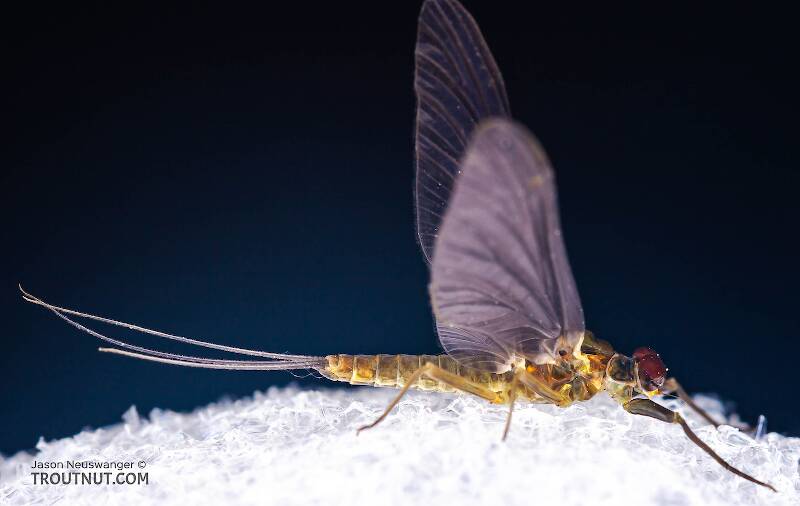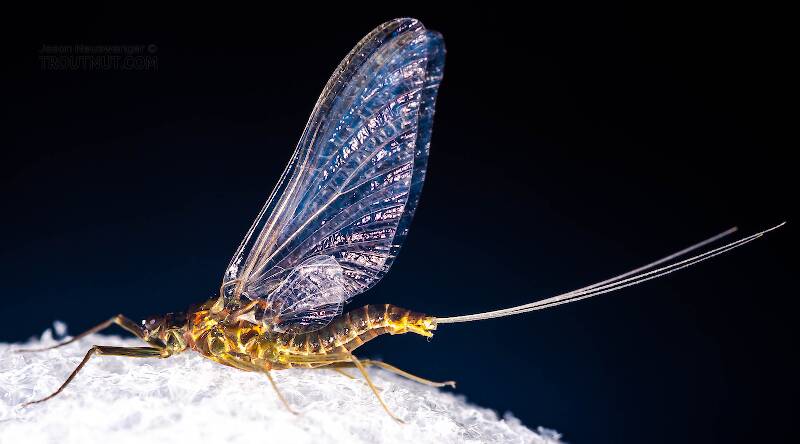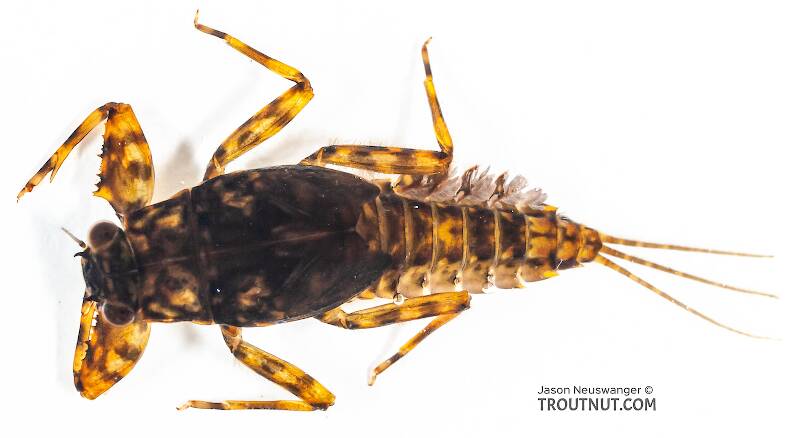
Hex Mayflies
Hexagenia limbata
The famous nocturnal Hex hatch of the Midwest (and a few other lucky locations) stirs to the surface mythically large brown trout that only touch streamers for the rest of the year.
Featured on the forum

As far as I can tell, this species has only previously been reported from one site in Oregon along the Columbia gorge. However, the key characteristics are fairly unmistakable in all except for one minor detail:
— 4 small yellow spots on frons visible in photos
— Narrow occipital spinule row curves forward (but doesn’t quite meet on stem of ecdysial suture, as it's supposed to in this species)
— Short spinules on anterior margin of front legs
— Short rposterior row of blunt spinules on abdominal tergae, rather than elongated spinules dorsally
I caught several of these mature nymphs in the fishless, tiny headwaters of a creek high in the Wenatchee Mountains.
— 4 small yellow spots on frons visible in photos
— Narrow occipital spinule row curves forward (but doesn’t quite meet on stem of ecdysial suture, as it's supposed to in this species)
— Short spinules on anterior margin of front legs
— Short rposterior row of blunt spinules on abdominal tergae, rather than elongated spinules dorsally
I caught several of these mature nymphs in the fishless, tiny headwaters of a creek high in the Wenatchee Mountains.

Troutnut is a project started in 2003 by salmonid ecologist Jason "Troutnut" Neuswanger to help anglers and
fly tyers unabashedly embrace the entomological side of the sport. Learn more about Troutnut or
support the project for an enhanced experience here.
Large Blue-Winged Olives
Like most common names,"Large Blue-Winged Olive" can refer to more than one taxon. They're previewed below, along with 3 specimens. For more detail click through to the scientific names.
Mayfly Species Drunella cornuta
These are pretty much always called Large Blue-Winged Olives.
Though not as well known as the Hendrickson and Sulphur hatches of the Ephemerella genus, Drunella cornuta (Olive Morning Dun or Large Blue-Winged Olive) is nonetheless an important Eastern hatch.
Lloyd Gonzales, in his book Fly-Fishing Pressured Water, notes that this attractive olive-green mayfly can provide good-to-excellent morning fishing in the faster sections of many streams. He also mentions that it can hatch in surprising numbers and usually faces less competition for the trout's attention than many of the spring or evening-emerging ephemerellids. Yet, cornuta and its sister species have largely escaped the limelight. The renowned twilight hatches of big Ephemera drakes and many other popular mayfly species command fly fisher's attention at this time of year. As the days lengthen, fishing all of the available mayfly hatches would require a pretty long day astream, so most anglers choose to focus on the late afternoon and evening activity.
Nature seems to have several recurrent color themes, and one of these is gray-winged/olive-bodied aquatic insects. Perhaps this explains why the name "Blue-Winged Olive" is often held up as the poster child for common name confusion. It has been freely applied to a multitude of mayflies in various families, genera, and species. Prior to having a well-established common name, this mayfly was referred to by Gonzales as the Olive Morning Dun. However, it has already been added to the long list of "BWOs" on many Eastern/Midwestern hatch charts.
Lloyd Gonzales, in his book Fly-Fishing Pressured Water, notes that this attractive olive-green mayfly can provide good-to-excellent morning fishing in the faster sections of many streams. He also mentions that it can hatch in surprising numbers and usually faces less competition for the trout's attention than many of the spring or evening-emerging ephemerellids. Yet, cornuta and its sister species have largely escaped the limelight. The renowned twilight hatches of big Ephemera drakes and many other popular mayfly species command fly fisher's attention at this time of year. As the days lengthen, fishing all of the available mayfly hatches would require a pretty long day astream, so most anglers choose to focus on the late afternoon and evening activity.
Nature seems to have several recurrent color themes, and one of these is gray-winged/olive-bodied aquatic insects. Perhaps this explains why the name "Blue-Winged Olive" is often held up as the poster child for common name confusion. It has been freely applied to a multitude of mayflies in various families, genera, and species. Prior to having a well-established common name, this mayfly was referred to by Gonzales as the Olive Morning Dun. However, it has already been added to the long list of "BWOs" on many Eastern/Midwestern hatch charts.
See 3 more specimens...
Mayfly Species Drunella walkeri
These are often called Large Blue-Winged Olives.
Ernest Schwiebert had this to say about the hatches of this chunky Eastern Drunella (Blue-Winged Olive) species:
See the Drunella and Drunella cornuta hatch pages for additional information.
An imitation is rarely required, but notes show that when it is needed it is needed badly.
See the Drunella and Drunella cornuta hatch pages for additional information.
References
- Schwiebert, Ernest G. 1955. Matching the Hatch. MacMillan Publishing Company.




